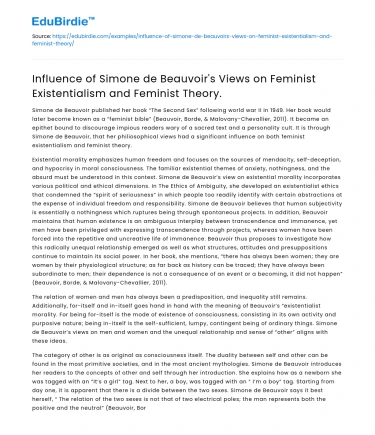Simone de Beauvoir published her book “The Second Sex” following world war II in 1949. Her book would later become known as a “feminist bible” (Beauvoir, Borde, & Malovany-Chevallier, 2011). It became an epithet bound to discourage impious readers wary of a sacred text and a personality cult. It is through Simone de Beauvoir, that her philiosophical views had a significant influence on both feminist existentialism and feminist theory.
Existential morality emphasizes human freedom and focuses on the sources of mendacity, self-deception, and hypocrisy in moral consciousness. The familiar existential themes of anxiety, nothingness, and the absurd must be understood in this context. Simone de Beauvoir’s view on existential morality incorporates various political and ethical dimensions. In The Ethics of Ambiguity, she developed an existentialist ethics that condemned the “spirit of seriousness” in which people too readily identify with certain abstractions at the expense of individual freedom and responsibility. Simone de Beauvoir believes that human subjectivity is essentially a nothingness which ruptures being through spontaneous projects. In addition, Beauvoir maintains that human existence is an ambiguous interplay between transcendence and immanence, yet men have been privileged with expressing transcendence through projects, whereas women have been forced into the repetitive and uncreative life of immanence. Beauvoir thus proposes to investigate how this radically unequal relationship emerged as well as what structures, attitudes and presuppositions continue to maintain its social power. In her book, she mentions, “there has always been women; they are women by their physiological structure; as far back as history can be traced; they have always been subordinate to men; their dependence is not a consequence of an event or a becoming, it did not happen” (Beauvoir, Borde, & Malovany-Chevallier, 2011).
Save your time!
We can take care of your essay
- Proper editing and formatting
- Free revision, title page, and bibliography
- Flexible prices and money-back guarantee
The relation of women and men has always been a predisposition, and inequality still remains. Additionally, for-itself and in-itself goes hand in hand with the meaning of Beauvoir’s “existentialist morality. For being for-itself is the mode of existence of consciousness, consisting in its own activity and purposive nature; being in-itself is the self-sufficient, lumpy, contingent being of ordinary things. Simone de Beauvoir’s views on men and women and the unequal relationship and sense of “other” aligns with these ideas.
The category of other is as original as consciousness itself. The duality between self and other can be found in the most primitive societies, and in the most ancient mythologies. Simone de Beauvoir introduces her readers to the concepts of other and self through her introduction. She explains how as a newborn she was tagged with an “It’s a girl” tag. Next to her, a boy, was tagged with an “ I’m a boy” tag. Starting from day one, it is apparent that there is a divide between the two sexes. Simone de Beauvoir says it best herself, “ The relation of the two sexes is not that of two electrical poles; the man represents both the positive and the neutral” (Beauvoir, Borde, & Malovany-Chevallier, 2011). The binary of self and other is perhaps one of the most basic theories of human. consciousness and identity, claiming, in short, that the existence of an other, a not-self, allows the possibility or recognition of a self. In Simone de Beauvoir’s view, individuals and groups have no choice but to recognize the reciprocity of their relationship. It is only for the “other” that there is self. For women is the other of man, animal is the other of human, and so on. We require “others” in order to define “self”.
According to Simone de Beauvoir, men and women are differently situated within society. It is due to women's unfreedom. Women have an unequal position in society and their subordination to and dependence on men. Simone de Beauvoir’s idea finds its philosophical articulation in the notion of woman as “Other.” Not only are women unfree in a material sense, having fewer resources and fewer opportunities than men, but at a more universal level women are unfree because they are conceived of as the “Other.” This existential Otherness, Beauvoir argues, defines the general situation of woman and helps to explain her material and social unfreedom. To be Other in this existential sense means to be the passive object to man's active subject. Simone de Beauvoir wrote, “she determines and differentiates herself in relation to man, and he does not in relation to her; she is the inessential in front of the essential” (Beauvoir, Borde, & Malovany-Chevallier, 2011). Beauvoir is clear that man casts woman into this position.
However, Simone de Beauvoir believes that woman does not reject her position as the Other, as man's passive and dependent counterpart, rather she accepts and even embraces this position, despite the fact that it is one in which her “humanity is effectively denied” and her freedom is suppressed.
By the 'second sex,' Simone de Beauvoir means that women are conditioned by society to understand themselves only in relation to men, whereas men are defined on their own terms. In other words, a woman's identity is defined by her relationship to a man. By understanding “existentialist morality”, it allows Reusch and Bateson’s 4 networks to function within the framework of “existentialist morality and assist in the effort of abiding by Beauvoir’s idea. Reusch and Bateson’s 4 networks of communication cover the Intrapersonal Network, Interpersonal Network, Group Network, and Cultural Network. Ultimately, understanding these key components of communication will help you understand how you’re perceiving gender, and how you experience both your own and others.






 Stuck on your essay?
Stuck on your essay?

